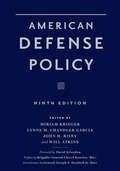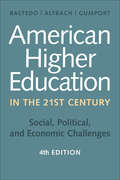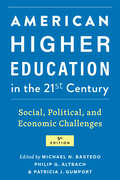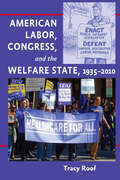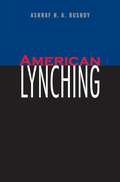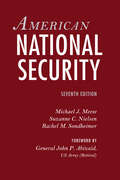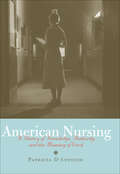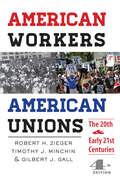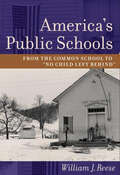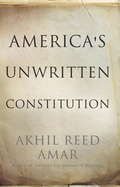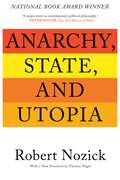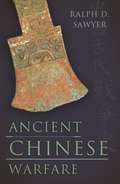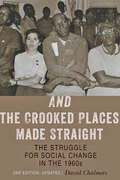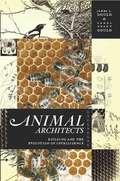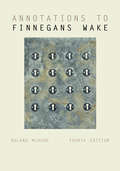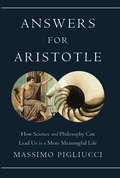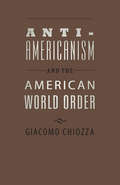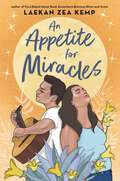- Table View
- List View
American Defense Policy
by Miriam Krieger Lynne M. Chandler Garcia John H. Riley Will AtkinsA vital text for understanding the twenty-first-century battlefield and the shifting force structure, this book prepares students to think critically about the rapidly changing world they'll inherit.American Defense Policy, first published in 1965 under the leadership of Brent Scowcroft, has been a mainstay in courses on political science, international relations, military affairs, and American national security for more than 50 years. This updated and thoroughly revised ninth edition, which contains about 30% all-new content, considers questions of continuity and change in America's defense policy in the face of a global climate beset by geopolitical tensions, rapid technological change, and terrorist violence.The book is organized into three parts. Part I examines the theories and strategies that shape America's approach to security policy. Part II dives inside the defense policy process, exploring the evolution of contemporary civil-military relations, the changing character of the profession of arms, and the issues and debates in the budgeting, organizing, and equipping process. Part III examines how purpose and process translate into American defense policy. This invaluable and prudent text remains a classic introduction to the vital security issues the United States has faced throughout its history. It breaks new ground as a thoughtful and comprehensive starting point to understand American defense policy and its role in the world today.Contributors: Gordon Adams, John R. Allen, Will Atkins, Deborah D. Avant, Michael Barnett, Sally Baron, Jeff J.S. Black, Jessica Blankshain, Hal Brands, Ben Buchanan, Dale C. Copeland, Everett Carl Dolman, Jeffrey Donnithorne, Daniel W. Drezner, Colin Dueck, Eric Edelman, Martha Finnemore, Lawrence Freedman, Francis Fukuyama, Michael D. Gambone, Lynne Chandler Garcia, Bishop Garrison, Erik Gartzke, Mauro Gilli, Robert Gilpin, T.X. Hammes, Michael C. Horowitz, G. John Ikenberry, Bruce D. Jones, Tim Kane, Cheryl A. Kearney, David Kilcullen, Michael P. Kreuzer, Miriam Krieger, Seth Lazar, Keir A. Lieber, Conway Lin, Jon R. Lindsay, Austin Long, Joseph S. Lupa Jr., Megan H. MacKenzie, Mike J. Mazarr, Senator John McCain, Daniel H. McCauley, Michael E. McInerney, Christopher D. Miller, James N. Miller, John A. Nagl, Henry R. Nau, Renée de Nevers, Joseph S. Nye Jr., Michael E. O'Hanlon, Mancur Olson Jr., Sue Payton, Daryl G. Press, Thomas Rid, John Riley, David Sacko, Brandon D. Smith, James M. Smith, Don M. Snider, Sir Hew Strachan, Michael Wesley, Richard Zeckhauser
American Defense Policy
by Miriam Krieger, Lynne Chandler Garcia, John Riley, and Will AtkinsA vital text for understanding the twenty-first-century battlefield and the shifting force structure, this book prepares students to think critically about the rapidly changing world they'll inherit.American Defense Policy, first published in 1965 under the leadership of Brent Scowcroft, has been a mainstay in courses on political science, international relations, military affairs, and American national security for more than 50 years. This updated and thoroughly revised ninth edition, which contains about 30% all-new content, considers questions of continuity and change in America's defense policy in the face of a global climate beset by geopolitical tensions, rapid technological change, and terrorist violence.The book is organized into three parts. Part I examines the theories and strategies that shape America's approach to security policy. Part II dives inside the defense policy process, exploring the evolution of contemporary civil-military relations, the changing character of the profession of arms, and the issues and debates in the budgeting, organizing, and equipping process. Part III examines how purpose and process translate into American defense policy. This invaluable and prudent text remains a classic introduction to the vital security issues the United States has faced throughout its history. It breaks new ground as a thoughtful and comprehensive starting point to understand American defense policy and its role in the world today.Contributors: Gordon Adams, John R. Allen, Will Atkins, Deborah D. Avant, Michael Barnett, Sally Baron, Jeff J.S. Black, Jessica Blankshain, Hal Brands, Ben Buchanan, Dale C. Copeland, Everett Carl Dolman, Jeffrey Donnithorne, Daniel W. Drezner, Colin Dueck, Eric Edelman, Martha Finnemore, Lawrence Freedman, Francis Fukuyama, Michael D. Gambone, Lynne Chandler Garcia, Bishop Garrison, Erik Gartzke, Mauro Gilli, Robert Gilpin, T.X. Hammes, Michael C. Horowitz, G. John Ikenberry, Bruce D. Jones, Tim Kane, Cheryl A. Kearney, David Kilcullen, Michael P. Kreuzer, Miriam Krieger, Seth Lazar, Keir A. Lieber, Conway Lin, Jon R. Lindsay, Austin Long, Joseph S. Lupa Jr., Megan H. MacKenzie, Mike J. Mazarr, Senator John McCain, Daniel H. McCauley, Michael E. McInerney, Christopher D. Miller, James N. Miller, John A. Nagl, Henry R. Nau, Renée de Nevers, Joseph S. Nye Jr., Michael E. O'Hanlon, Mancur Olson Jr., Sue Payton, Daryl G. Press, Thomas Rid, John Riley, David Sacko, Brandon D. Smith, James M. Smith, Don M. Snider, Sir Hew Strachan, Michael Wesley, Richard Zeckhauser
American Higher Education in the Twenty-First Century: Social, Political, and Economic Challenges
by Michael N. Bastedo Philip G. Altbach Patricia J. GumportFirst published in 1999, American Higher Education in the Twenty-First Century offered a comprehensive introduction to the central issues facing American colleges and universities. This thoroughly revised edition brings the classic volume up to date. The contributors have rewritten every chapter to address major changes in higher education, including the rise of organized social movements, the problem of income inequality and stratification, and the growth of for-profit and distance education. Three new chapters cover information technology, community colleges, and teaching and learning.This edition seeks to capture several crucial dynamics in the nexus of higher education and society. Placing higher education within its social and political contexts, the contributors discuss finance, federal and state governance, faculty, students, curriculum, and academic leadership. They also grapple with growing concerns about the future of the academy and reflect more deeply on the racial, ethnic, and socioeconomic diversity within higher education.No other book covers such wide-ranging issues under the broader theme of higher education;€™s relationship to society. Highly acclaimed and incorporating cutting-edge research, American Higher Education in the Twenty-First Century is now more useful and engaging than ever.Contributors: Michael N. Bastedo, Philip G. Altbach, Patricia J. Gumport, Benjamin Baez, Peter Riley Bahr, Joy Blanchard, Corbin M. Campbell, Melanie E. Corrigan, Peter D. Eckel, Roger L. Geiger, Lawrence E. Gladieux, Sara Goldrick-Rab, Jillian Leigh Gross, D. Bruce Johnstone, Adrianna Kezar, Jacqueline E. King, Aims C. McGuinness, Jr., Michael Mumper, Anna Neumann, Robert M. O;€™Neil, Laura W. Perna, Gary Rhoades, Roman Ruiz, Lauren Schudde, Sheila Slaughter, Daryl G. Smith
American Higher Education in the Twenty-First Century: Social, Political, and Economic Challenges
by Michael N. Bastedo Philip G. Altbach Patricia J. GumportFirst published in 1999, American Higher Education in the Twenty-First Century offered a comprehensive introduction to the central issues facing American colleges and universities. This thoroughly revised edition brings the classic volume up to date. The contributors have rewritten every chapter to address major changes in higher education, including the rise of organized social movements, the problem of income inequality and stratification, and the growth of for-profit and distance education. Three new chapters cover information technology, community colleges, and teaching and learning.This edition seeks to capture several crucial dynamics in the nexus of higher education and society. Placing higher education within its social and political contexts, the contributors discuss finance, federal and state governance, faculty, students, curriculum, and academic leadership. They also grapple with growing concerns about the future of the academy and reflect more deeply on the racial, ethnic, and socioeconomic diversity within higher education.No other book covers such wide-ranging issues under the broader theme of higher education;€™s relationship to society. Highly acclaimed and incorporating cutting-edge research, American Higher Education in the Twenty-First Century is now more useful and engaging than ever.Contributors: Michael N. Bastedo, Philip G. Altbach, Patricia J. Gumport, Benjamin Baez, Peter Riley Bahr, Joy Blanchard, Corbin M. Campbell, Melanie E. Corrigan, Peter D. Eckel, Roger L. Geiger, Lawrence E. Gladieux, Sara Goldrick-Rab, Jillian Leigh Gross, D. Bruce Johnstone, Adrianna Kezar, Jacqueline E. King, Aims C. McGuinness, Jr., Michael Mumper, Anna Neumann, Robert M. O;€™Neil, Laura W. Perna, Gary Rhoades, Roman Ruiz, Lauren Schudde, Sheila Slaughter, Daryl G. Smith
American Higher Education in the Twenty-First Century: Social, Political, and Economic Challenges
by Michael N. Bastedo Philip G. Altbach Patricia J. GumportNow in its fifth edition! An indispensable reference for anyone concerned with the future of American colleges and universities.Whether it is advances in information technology, organized social movements, or racial inequality and social class stratification, higher education serves as a lens for examining significant issues within American society. First published in 1998, American Higher Education in the Twenty-First Century offers a comprehensive introduction to the complex realities of American higher education, including its history, financing, governance, and relationship with the states and federal government. This thoroughly revised edition brings the classic volume completely up to date. Each chapter has been rewritten to address major recent issues in higher education, including the COVID-19 pandemic, the movement for racial justice, and turmoil in the for-profit sector. Three entirely new chapters cover broad-access colleges, race and racism, and organized social movements. Reflecting on the implications of ethnic and socioeconomic diversity within higher education, the book also grapples with growing concerns about the responsiveness and future of the academy.No other book covers such wide-ranging issues under the broader theme of higher education's relationship to society. Highly acclaimed and incorporating cutting-edge research, American Higher Education in the Twenty-First Century is now more useful and engaging than ever.Contributors: Michael N. Bastedo, Philip G. Altbach, Patricia J. Gumport, Peter Riley Bahr, Joy Blanchard, Julia Brickfield, Michael Brown, Katherine S. Cho, Daniela Conde, Charles H. F. Davis III, Hans de Wit, Peter D. Eckel, Martin Finkelstein, Denisa Gándara, Liliana M. Garces, Roger L. Geiger, Leslie D. Gonzales, Jillian Leigh Gross, Jessica Harris, Nicholas Hillman, Julia Rose Karpicz, Robert Kelchen, Adrianna Kezar, Lisa R. Lattuca, Demetri Morgan, Rebecca Natow, Anna Neumann, Audrey Peek, Laura W. Perna, Gary Rhoades, Tykeia N. Robinson, Roman Ruiz, Wonson Ryu, Lauren T. Schudde, Jeffrey C. Sun, David A. Tandberg
American Higher Education in the Twenty-First Century: Social, Political, and Economic Challenges
by Michael N. Bastedo, Philip G. Altbach, and Patricia J. GumportNow in its fifth edition! An indispensable reference for anyone concerned with the future of American colleges and universities.Whether it is advances in information technology, organized social movements, or racial inequality and social class stratification, higher education serves as a lens for examining significant issues within American society. First published in 1998, American Higher Education in the Twenty-First Century offers a comprehensive introduction to the complex realities of American higher education, including its history, financing, governance, and relationship with the states and federal government. This thoroughly revised edition brings the classic volume completely up to date. Each chapter has been rewritten to address major recent issues in higher education, including the COVID-19 pandemic, the movement for racial justice, and turmoil in the for-profit sector. Three entirely new chapters cover broad-access colleges, race and racism, and organized social movements. Reflecting on the implications of ethnic and socioeconomic diversity within higher education, the book also grapples with growing concerns about the responsiveness and future of the academy.No other book covers such wide-ranging issues under the broader theme of higher education's relationship to society. Highly acclaimed and incorporating cutting-edge research, American Higher Education in the Twenty-First Century is now more useful and engaging than ever.Contributors: Michael N. Bastedo, Philip G. Altbach, Patricia J. Gumport, Peter Riley Bahr, Joy Blanchard, Julia Brickfield, Michael Brown, Katherine S. Cho, Daniela Conde, Charles H. F. Davis III, Hans de Wit, Peter D. Eckel, Martin Finkelstein, Denisa Gándara, Liliana M. Garces, Roger L. Geiger, Leslie D. Gonzales, Jillian Leigh Gross, Jessica Harris, Nicholas Hillman, Julia Rose Karpicz, Robert Kelchen, Adrianna Kezar, Lisa R. Lattuca, Demetri Morgan, Rebecca Natow, Anna Neumann, Audrey Peek, Laura W. Perna, Gary Rhoades, Tykeia N. Robinson, Roman Ruiz, Wonson Ryu, Lauren T. Schudde, Jeffrey C. Sun, David A. Tandberg
American Labor, Congress, and the Welfare State, 1935–2010
by Tracy RoofDespite achieving monumental reforms in the United States such as the eight-hour workday, a federal minimum wage, and workplace health and safety laws, organized labor’s record on much of its agenda has been mixed. Tracy Roof’s sweeping examination of labor unions and the American legislative process explains how this came to be and what it means for American workers.Tracing a 75-year arc in labor movement history, Roof discusses the complex interplay between unions and Congress, showing the effects of each on the other, how the relationship has evolved, and the resulting political outcomes. She analyzes labor’s success at passing legislation and pushing political reform in the face of legislative institutional barriers such as the Senate filibuster and an entrenched and powerful committee structure, looks at the roots and impact of the interdependent relationship between the Democratic Party and the labor movement, and assesses labor’s prospects for future progress in creating a comprehensive welfare state. Roof’s original investigation details the history, actions, and consequences of major policy battles over areas such as labor law reform and health care policy. In the process, she brings to light practical and existential questions for labor leaders, scholars, and policy makers.Although American labor remains a force within the political process, decades of steadily declining membership and hostile political forces pose real threats to the movement. Roof’s shrewd exploration of unions, Congress, and the political process challenges conventional explanations for organized labor’s political failings.
American Labor, Congress, and the Welfare State, 1935–2010
by Tracy RoofDespite achieving monumental reforms in the United States such as the eight-hour workday, a federal minimum wage, and workplace health and safety laws, organized labor’s record on much of its agenda has been mixed. Tracy Roof’s sweeping examination of labor unions and the American legislative process explains how this came to be and what it means for American workers.Tracing a 75-year arc in labor movement history, Roof discusses the complex interplay between unions and Congress, showing the effects of each on the other, how the relationship has evolved, and the resulting political outcomes. She analyzes labor’s success at passing legislation and pushing political reform in the face of legislative institutional barriers such as the Senate filibuster and an entrenched and powerful committee structure, looks at the roots and impact of the interdependent relationship between the Democratic Party and the labor movement, and assesses labor’s prospects for future progress in creating a comprehensive welfare state. Roof’s original investigation details the history, actions, and consequences of major policy battles over areas such as labor law reform and health care policy. In the process, she brings to light practical and existential questions for labor leaders, scholars, and policy makers.Although American labor remains a force within the political process, decades of steadily declining membership and hostile political forces pose real threats to the movement. Roof’s shrewd exploration of unions, Congress, and the political process challenges conventional explanations for organized labor’s political failings.
American Lynching
by Ashraf H. RushdyAfter observing the varying reactions to the 1998 death of James Byrd Jr. in Texas, called a lynching by some, denied by others, Ashraf Rushdy determined that to comprehend this event he needed to understand the long history of lynching in the United States. In this meticulously researched and accessibly written interpretive history, Rushdy shows how lynching in America has endured, evolved, and changed in meaning over the course of three centuries, from its origins in early Virginia to the present day.Rushdy argues that we can understand what lynching means in American history by examining its evolution—that is, by seeing how the practice changes in both form and meaning over the course of three centuries, by analyzing the rationales its advocates have made in its defense, and, finally, by explicating its origins. The best way of understanding what lynching has meant in different times, and for different populations, during the course of American history is by seeing both the continuities in the practice over time and the specific features in different forms of lynching in different eras.
American National Security
by Michael J. Meese Suzanne C. Nielsen Rachel M. SondheimerAmerican National Security remains the ideal foundational text for courses in national security, foreign policy, and security studies. Every chapter in this edition has been extensively revised, and the book includes discussion of recent security policy changes in the Trump administration. Highlights include:;€¢ An updated look at national security threats, military operations, and homeland security challenges ;€¢ An analysis of the evolving roles of the president, Congress, the intelligence community, the military, and other institutions involved in national security;€¢ A revised consideration of the strengths, limitations, and employment of instruments of national power, including diplomacy, information, economic tools, and armed forces;€¢ An exploration of the economic and national security implications of globalization;€¢ An enhanced examination of the proliferation of transnational threats, including security challenges in space and in cyberspace;€¢ A new assessment of how international, political, and economic trends may change US leadership of the post;€“World War II international order;€¢ A comprehensive update on changing dynamics in key states and regions, including Russia, China, East Asia, the Middle East, South Asia, Europe, Sub-Saharan Africa, and Latin AmericaAn authoritative book that explains US national security policy, actors, and processes in a wide-ranging yet understandable way, American National Security addresses key issues, including challenges to the free and open international order, the reemergence of strategic competition among great powers, terrorism, economic and fiscal constraints, and rapid advances in information and technology.
American Nursing: A History of Knowledge, Authority, and the Meaning of Work
by Patricia D'AntonioThis new interpretation of the history of nursing in the United States captures the many ways women reframed the most traditional of all gender expectations—that of caring for the sick—to create new possibilities for themselves, to renegotiate the terms of some of their life experiences, and to reshape their own sense of worth and power. For much of modern U.S. history, nursing was informal, often uncompensated, and almost wholly the province of female family and community members. This began to change at the end of the nineteenth century when the prospect of formal training opened for women doors that had been previously closed. Nurses became respected professionals, and becoming a formally trained nurse granted women a range of new social choices and opportunities that eventually translated into economic mobility and stability. Patricia D'Antonio looks closely at this history—using a new analytic framework and a rich trove of archival sources—and finds complex, multiple meanings in the individual choices of women who elected a nursing career. New relationships and social and professional options empowered nurses in constructing consequential lives, supporting their families, and participating both in their communities and in the health care system. Narrating the experiences of nurses, D'Antonio captures the possibilities, power, and problems inherent in the different ways women defined their work and lived their lives. Scholars in the history of medicine, nursing, and public policy, those interested in the intersections of identity, work, gender, education, and race, and nurses will find this a provocative book.
American Workers, American Unions: The Twentieth and Early Twenty-First Centuries (The American Moment)
by Robert H. Zieger Timothy J. Minchin Gilbert J. GallHighly acclaimed and widely read since its first publication in 1986, American Workers, American Unions provides a concise and compelling history of American workers and their unions in the twentieth century and the first decade of the twenty-first. Taking into account recent important work on the 1970s and the Reagan revolution, the fourth edition newly considers the stagflation issue, the rise of globalization and big box retailing, the failure of Congress to pass legislation supporting the right of public employees to collective bargaining, the defeat in Congress of legislation to revise the National Labor Relations Act, the emasculation of the Humphrey-Hawkins Act, and the changing dynamics of blue-collar politics. In addition to important new information on the 1970s and 1980s, the fourth edition contains a completely new final chapter. Largely written by Timothy J. Minchin, this chapter provides a rare survey of American workers and their unions between 9/11 and the 2012 presidential election. Gilbert J. Gall presents new information on government workers and their recent battles to defend workplace rights.
American Workers, American Unions: The Twentieth and Early Twenty-First Centuries (The American Moment)
by Robert H. Zieger Timothy J. Minchin Gilbert J. GallHighly acclaimed and widely read since its first publication in 1986, American Workers, American Unions provides a concise and compelling history of American workers and their unions in the twentieth century and the first decade of the twenty-first. Taking into account recent important work on the 1970s and the Reagan revolution, the fourth edition newly considers the stagflation issue, the rise of globalization and big box retailing, the failure of Congress to pass legislation supporting the right of public employees to collective bargaining, the defeat in Congress of legislation to revise the National Labor Relations Act, the emasculation of the Humphrey-Hawkins Act, and the changing dynamics of blue-collar politics. In addition to important new information on the 1970s and 1980s, the fourth edition contains a completely new final chapter. Largely written by Timothy J. Minchin, this chapter provides a rare survey of American workers and their unions between 9/11 and the 2012 presidential election. Gilbert J. Gall presents new information on government workers and their recent battles to defend workplace rights.
America's Public Schools: From the Common School to "No Child Left Behind" (The American Moment)
by William J. ReeseIn this update to his landmark publication, William J. Reese offers a comprehensive examination of the trends, theories, and practices that have shaped America’s public schools over the last two centuries. Reese approaches this subject along two main lines of inquiry—education as a means for reforming society and ongoing reform within the schools themselves. He explores the roots of contemporary educational policies and places modern battles over curriculum, pedagogy, race relations, and academic standards in historical perspective.A thoroughly revised epilogue outlines the significant challenges to public school education within the last five years. Reese analyzes the shortcomings of "No Child Left Behind" and the continued disjuncture between actual school performance and the expectations of government officials. He discusses the intrusive role of corporations, economic models for enticing better teacher performance, the continued impact of conservatism, and the growth of home schooling and charter schools. Informed by a breadth of historical scholarship and based squarely on primary sources, this volume remains the standard text for future teachers and scholars of education.
America's Unwritten Constitution: The Precedents and Principles We Live By
by Akhil Reed AmarAmerica's Unwritten Constitution presents a bold new vision of the American constitutional system, one in which proper interpretation of the Constitution rests on the interplay between its written and unwritten manifestations, but in which interpretation does not, and cannot, depend wholly on one form or the other. Neither America's written Constitution nor its unwritten Constitution stands alone, Amar shows, and with each eye-opening example he develops a deeper, more compelling way of thinking about constitutional law than has ever been put forth before-a methodology that looks past the basic text to reveal the diverse influences, supplements, and possibilities that comprise it.
America's Unwritten Constitution: The Precedents and Principles We Live By
by Akhil Reed AmarDespite its venerated place atop American law and politics, our written Constitution does not enumerate all of the rules and rights, principles and procedures that actually govern modern America. The document makes no explicit mention of cherished concepts like the separation of powers and the rule of law. On some issues, the plain meaning of the text misleads. For example, the text seems to say that the vice president presides over his own impeachment trial -- but surely this cannot be right. As esteemed legal scholar Akhil Reed Amar explains in America's Unwritten Constitution, the solution to many constitutional puzzles lies not solely within the written document, but beyond it -- in the vast trove of values, precedents, and practices that complement and complete the terse text. In this sequel to America's Constitution: A Biography, Amar takes readers on a tour of our nation's unwritten Constitution, showing how America's foundational document cannot be understood in textual isolation. Proper constitutional interpretation depends on a variety of factors, such as the precedents set by early presidents and Congresses; common practices of modern American citizens; venerable judicial decisions; and particularly privileged sources of inspiration and guidance, including the Federalist papers, William Blackstone's Commentaries on the Laws of England, the Northwest Ordinance of 1787, Lincoln's Gettysburg Address, and Martin Luther King, Jr.'s "I Have a Dream" speech. These diverse supplements are indispensible instruments for making sense of the written Constitution. When used correctly, these extra-textual aids support and enrich the written document without supplanting it. An authoritative work by one of America's preeminent legal scholars, America's Unwritten Constitution presents a bold new vision of the American constitutional system, showing how the complementary relationship between the Constitution's written and unwritten components is one of America's greatest and most enduring strengths.
Anarchy, State, and Utopia: Second Edition
by Robert NozickThe foundational text of libertarian thought, named one of the 100 Most Influential Books since World War II (Times Literary Supplement)First published in response to John Rawls' A Theory of Justice, Robert Nozick's Anarchy, State, and Utopia has become a defining text of classic libertarian thought. Challenging and ultimately rejecting liberal, socialist, and conservative agendas, Nozick boldly asserts that the rights of individuals are violated as a state's responsibilities increase -- and that the only way to avoid these violations is the creation of a minimalist state limited to the enforcement of contracts and to protection against force, fraud, and theft.Winner of the National Book Award and translated into over one hundred languages, Anarchy, State and Utopia remains one of the most theoretically trenchant and philosophically rich defenses of economic liberalism to date. With an introduction by philosopher Thomas Nagel, this edition brings Nozick and his work to today's generation of readers.
Ancient Chinese Warfare
by Ralph D. SawyerThe history of China is a history of warfare. Rarely in its 3,000-year existence has the country not been beset by war, rebellion, or raids. Warfare was a primary source of innovation, social evolution, and material progress in the Legendary Era, Hsia dynasty, and Shang dynasty--indeed, war was the force that formed the first cohesive Chinese empire, setting China on a trajectory of state building and aggressive activity that continues to this day.In Ancient Chinese Warfare, a preeminent expert on Chinese military history uses recently recovered documents and archaeological findings to construct a comprehensive guide to the developing technologies, strategies, and logistics of ancient Chinese militarism. The result is a definitive look at the tools and methods that won wars and shaped culture in ancient China.
And the Crooked Places Made Straight: The Struggle for Social Change in the 1960s (The American Moment)
by David ChalmersDavid Chalmers's widely acclaimed overview of the 1960s describes how the civil rights movement touched off a growing challenge to traditional values and arrangements. Chalmers recounts the judicial revolution that set national standards for race, politics, policing, and privacy. He examines the long, losing war on poverty and the struggle between the media and the government over the war in Vietnam. He follows feminism's "second wave" and the emergence of the environmental, consumer, and citizen action movements. He also explores the worlds of rock, sex, and drugs, and the entwining of the youth culture, the counterculture, and the American marketplace.This newly revised edition covers the conservative counter-revolution and cultural wars. It carries the legacy of the 1960s forward: from Tom Hayden’s idealistic 1962 Port Huron Statement through Newt Gingrich’s 1994 "Contract with America" and Grover Norquist’s twenty-first century "Tax Payer’s Protection Pledge."
And the Crooked Places Made Straight: The Struggle for Social Change in the 1960s (The American Moment)
by David ChalmersDavid Chalmers's widely acclaimed overview of the 1960s describes how the civil rights movement touched off a growing challenge to traditional values and arrangements. Chalmers recounts the judicial revolution that set national standards for race, politics, policing, and privacy. He examines the long, losing war on poverty and the struggle between the media and the government over the war in Vietnam. He follows feminism's "second wave" and the emergence of the environmental, consumer, and citizen action movements. He also explores the worlds of rock, sex, and drugs, and the entwining of the youth culture, the counterculture, and the American marketplace.This newly revised edition covers the conservative counter-revolution and cultural wars. It carries the legacy of the 1960s forward: from Tom Hayden’s idealistic 1962 Port Huron Statement through Newt Gingrich’s 1994 "Contract with America" and Grover Norquist’s twenty-first century "Tax Payer’s Protection Pledge."
Animal Architects: Building and the Evolution of Intelligence
by James L. Gould Carol Grant GouldAnimal behavior has long been a battleground between the competing claims of nature and nurture, with the possible role of cognition in behavior as a recent addition to this debate. There is an untapped trove of behavioral data that can tell us a great deal about how the animals draw from these neural strategies: The structures animals build provide a superb window on the workings of the animal mind. Animal Architects examines animal architecture across a range of species, from those whose blueprints are largely innate (such as spiders and their webs) to those whose challenging structures seem to require intellectual insight, planning, and even aesthetics (such as bowerbirds' nests, or beavers' dams). Beginning with instinct and the simple homes of solitary insects, James and Carol Gould move on to conditioning; the "cognitive map” and how it evolved; and the role of planning and insight. Finally, they reflect on what animal building tells us about the nature of human intelligence-showing why humans, unlike many animals, need to build castles in the air.
Annotations to Finnegans Wake
by Roland McHughRoland McHugh’s classic Annotations to Finnegans Wake provides both novice readers and seasoned Joyceans with a wealth of information in an easy-to-use format uniquely suited to this densely layered text. Each page of the Annotations corresponds directly to a page of the standard Viking/Penguin edition of Finnegans Wake and contains line-by-line notes following the placement of the passages to which they refer, enabling readers to look directly from text to notes and back again, with no need to consult separate glossaries or other listings.McHugh’s richly detailed annotations distill decades of scholarship, explicating foreign words, unusual English connotations and colloquial expressions, place names, historical events, song titles and quotations, parodies of other texts, and Joyce’s diverse literary and popular sources. This thoroughly updated fourth edition draws heavily on Internet resources and keyword searches. For the first time, McHugh provides readers with a synopsis of the action of Finnegans Wake. He also expands his examination of possible textual corruption and adds hundreds of new glosses to help scholars, students, and general readers untangle the dense thicket of allusions that crowds every sentence of Joyce’s nearly inscrutable masterpiece.
Answers for Aristotle: How Science and Philosophy Can Lead Us to A More Meaningful Life
by Massimo PigliucciHow should we live? According to philosopher and biologist Massimo Pigliucci, the greatest guidance to this essential question lies in combining the wisdom of 24 centuries of philosophy with the latest research from 21st century science. In Answers for Aristotle, Pigliucci argues that the combination of science and philosophy first pioneered by Aristotle offers us the best possible tool for understanding the world and ourselves. As Aristotle knew, each mode of thought has the power to clarify the other: science provides facts, and philosophy helps us reflect on the values with which to assess them. But over the centuries, the two have become uncoupled, leaving us with questions—about morality, love, friendship, justice, and politics—that neither field could fully answer on its own. Pigliucci argues that only by rejoining each other can modern science and philosophy reach their full potential, while we harness them to help us reach ours. Pigliucci discusses such essential issues as how to tell right from wrong, the nature of love and friendship, and whether we can really ever know ourselves—all in service of helping us find our path to the best possible life. Combining the two most powerful intellectual traditions in history, Answers for Aristotle is a remarkable guide to discovering what really matters and why.
Anti-Americanism and the American World Order
by Giacomo ChiozzaNews stories remind us almost daily that anti-American opinion is rampant in every corner of the globe. Journalists, scholars, and politicians alike reinforce the perception that anti-Americanism is an entrenched sentiment in many foreign countries. Political scientist Giacomo Chiozza challenges this conventional wisdom, arguing that foreign public opinion about the U.S. is much more diverse and nuanced than is generally believed. Chiozza examines the character, source, and persistence of foreign attitudes toward the United States. His findings are based on worldwide public opinion databases that surveyed anti-American sentiment in Islamic countries, Europe, Latin America, Africa, and East Asia. Data compiled from responses in a wide range of categories—including politics, wealth, science and technology, popular culture, and education—indicate that anti-American sentiments vary widely across these geographic regions. Through careful analyses, Chiozza shows how foreign publics balance the political, social, and cultural dimensions of the U.S. in their own perceptions of the country. He finds that popular anti-Americanism is mostly benign and shallow; deep-seated ideological opposition to the U.S. is usually held among a minority of groups. More often, Chiozza explains, foreigners have conflicting attitudes toward the U.S. He finds that while anti-Americanism certainly exists, the United States is equally praised as a symbol of democracy and freedom, its ideals of liberty, equality, and opportunity applauded. Chiozza clearly demonstrates that what is reported as undisputed fact—that various groups abhor American values—is in reality a complex story.
An Appetite for Miracles
by Laekan Zea KempAward-winning author Laekan Zea Kemp&’s heart-wrenching novel-in-verse follows two teens who must come together to heal the pain from their pasts, perfect for fans of Elizabeth Acevedo and Nicola Yoon. Danna Mendoza Villarreal&’s grandfather is slowly losing himself as his memories fade, and Danna&’s not sure her plan to help him remember through the foods he once reviewed will be enough to bring him back. Especially when her own love of food makes her complicated relationship with her mother even more difficult. Raúl Santos has been lost ever since his mother was wrongly incarcerated two years ago. Playing guitar for the elderly has been his only escape, to help them remember and him forget. But when his mom unexpectedly comes back into his life, what is he supposed to do when she isn&’t the same person who left? When Danna and Raúl meet, sparks fly immediately and they embark on a mission to heal her grandfather ... and themselves. Because healing is something best done together—even if it doesn&’t always look the way we want it to.
